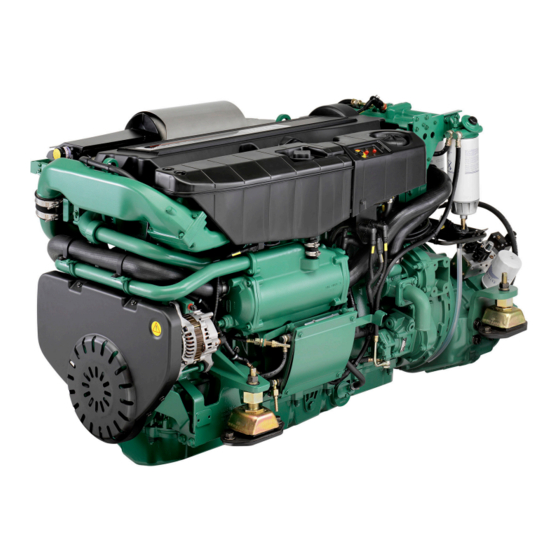
Table of Contents
Advertisement
Advertisement
Table of Contents

Summarization of Contents
Safety Information
Boat Operation Safety
Comprehensive safety guidelines for operating the boat and its engine.
Maintenance Safety
Essential safety precautions for performing maintenance and service tasks.
Specific Hazards
Information on hazards like CO poisoning, hot surfaces, chemicals, and system safety.
Introduction
Environmental Care
Emphasizes Volvo Penta's commitment to environmental protection.
Running In
Guides the user on the initial 10-hour engine run-in procedure.
Fuel and Oils
Stresses using recommended fuels and oils to prevent malfunctions.
Service and Spare Parts
Highlights the importance of using original parts for reliability and longevity.
Certified Engines
Important information regarding certified engines and their requirements.
Warranty
Details the warranty coverage and owner responsibilities.
Identification Numbers
Information on locating and recording engine and transmission identification numbers.
Presentation
Technical Description
Details the engine's construction and components.
Orientation
Visual guide to engine components with labels.
Instruments
Instrument Gauges
Identifies and describes various gauges and indicators on the control panel.
Ignition Lock and Start/Stop Panel
Explains the function of the ignition lock and start/stop panel.
Alarm Display
Explains the meaning and response to various warning lamps.
EVC Control Panel
Details the functions of the EVC control panel buttons and indicators.
EVC-Display (Extra Optional)
Information on the optional EVC-display unit for engine monitoring.
Controls
Single Lever Control Operation
Explains the operation and features of the single lever control.
Friction Brake Adjustment
How to adjust the friction brake for lever movement.
Starting the Engine
Pre-Start Checks
Lists essential checks and procedures before starting the engine.
Starting Methods
Step-by-step procedures for starting the engine using different methods.
Engine Warm-up
Guidance on warming up the engine after starting and checking levels.
Operation
Reading Instruments and Alarms
How to interpret engine instruments and respond to alarms.
Cruising Speed and Synchronization
Advice on optimizing cruising speed and synchronizing twin engines.
Control System Operation
Procedures for changing control positions and shifting gears.
Propeller Shaft Brake
Information on the propeller shaft brake mechanism.
Stopping the Engine
Engine Shutdown Procedures
Standard and emergency procedures for stopping the engine.
Post-Stop Checks
Actions to take after the engine has been stopped.
Cold Weather Precautions
Steps to protect the engine in cold weather conditions.
Laying Up Procedures
Instructions for preparing the boat for extended periods of non-use.
In Case of Emergency
Emergency Starting
Guidance on starting the engine using auxiliary batteries.
Emergency Shifting
Procedure for manually shifting the gear in an emergency.
Fault Tracing
Methods for identifying and diagnosing engine malfunctions.
Diagnostic Function
How the diagnostic system monitors and reports malfunctions.
Fault Codes
Procedures for reading and understanding fault codes.
Maintenance Schedule
General Maintenance Information
Overview of preventive maintenance and the importance of original parts.
Warranty Inspection
Requirement for the first service inspection by an authorized workshop.
Scheduled Maintenance Tasks
Lists maintenance tasks based on operating hours and time intervals.
Maintenance
Engine General Maintenance
General inspection and cleaning procedures for the engine.
Air Filter and Crankcase Ventilation
Procedures for changing the air filter and crankcase ventilation filter.
Drive Belts Maintenance
Inspection, adjustment, and replacement of drive belts.
Lubrication System
Oil Change Procedures
Information on oil change intervals, viscosity, and volume.
Oil Filter and Bypass Filter Change
Steps for replacing the oil and bypass filters.
Freshwater System
Coolant and Water Quality
Details on coolant types, mixing, and water quality requirements.
Coolant Level and Filling
Procedures for checking, topping up, and filling the coolant system.
Coolant Draining and System Flushing
Steps for draining coolant and flushing the freshwater system.
Seawater System
Seawater System Draining
Procedure for draining the seawater system to prevent frost damage.
Zinc Anodes and Impeller Maintenance
Checking and replacing zinc anodes and impellers.
Seawater Filter and Heat Exchanger Maintenance
Inspection and cleaning of the seawater filter and heat exchanger.
Inlet Manifold and Oil Cooler Maintenance
Checking drain holes and cleaning the oil cooler.
Fuel System
Fuel System Venting
Procedure to remove air from the fuel system.
Fuel Filter Maintenance
Draining and changing fuel filter elements.
Fuel Pre-filter Maintenance
Inspection, draining, and changing of fuel pre-filter inserts.
Electrical System
System Components and Safety
Information on main switches, fuses, EVC system, and connections.
Battery Maintenance and Charging
Procedures for battery maintenance, connection, and charging.
Electric Welding and Installations
Safety precautions for electric welding and electrical installations.
Reverse Gear
Oil Level and Strainer Maintenance
Procedures for checking oil level and cleaning the oil strainer.
Oil Filter and Seal Lubrication
Steps for changing the oil filter and lubricating seals.
Laying Up/Launching
Inhibiting for Storage
Procedures for preparing the engine for storage.
Bringing Out of Storage
Steps for preparing the engine after a period of storage.
Fault Code Register
Understanding Fault Codes
Explains how fault codes are presented, read, and interpreted.
Technical Data
General Specifications
General engine specifications like displacement, cylinders, and weight.
Fuel System Specifications
Details on fuel specifications and requirements.
Lubricating System Specifications
Information on oil capacity, pressure, grade, and viscosity.
Cooling System Specifications
Details on freshwater system capacity.
Electrical System Specifications
Information on system voltage, generators, and battery capacity.
Reverse Gear Specifications
Specifications for ZF and Twin Disc reverse gears.














Need help?
Do you have a question about the D9-575 and is the answer not in the manual?
Questions and answers